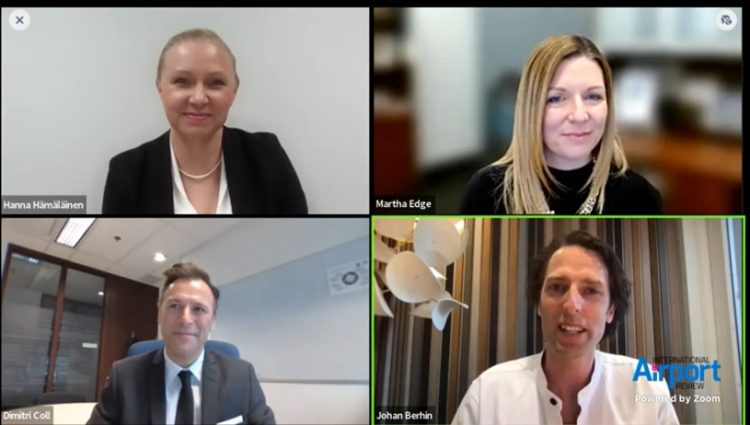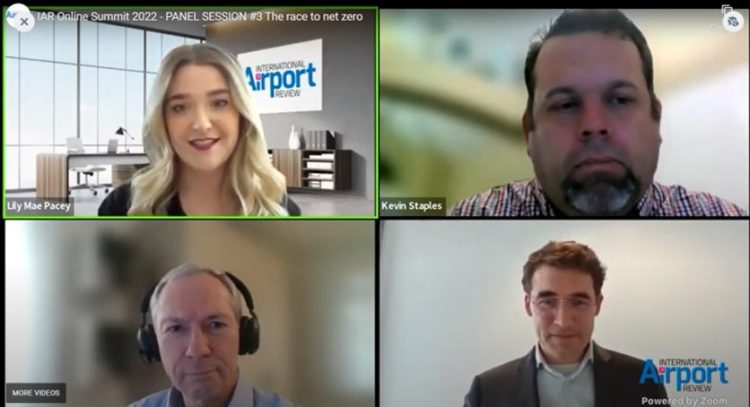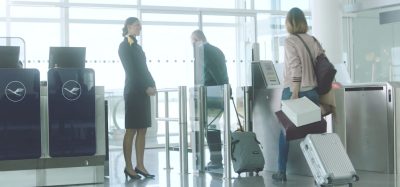Building Back Better: International Airport Online Summit Event review
- Like
- Digg
- Del
- Tumblr
- VKontakte
- Buffer
- Love This
- Odnoklassniki
- Meneame
- Blogger
- Amazon
- Yahoo Mail
- Gmail
- AOL
- Newsvine
- HackerNews
- Evernote
- MySpace
- Mail.ru
- Viadeo
- Line
- Comments
- Yummly
- SMS
- Viber
- Telegram
- Subscribe
- Skype
- Facebook Messenger
- Kakao
- LiveJournal
- Yammer
- Edgar
- Fintel
- Mix
- Instapaper
- Copy Link
Posted: 13 April 2022 | Holly Miles, Lily Mae Pacey (International Airport Review) | No comments yet
The International Airport Online Summit which took place on 15-17 March, was a huge success. In case you missed out, we have highlighted three of key panel sessions that we think you should catch up on.
It was an absolute pleasure to welcome you all to the International Airport Online Summit in March, which focused on how airports are aiming to build back better after the pandemic, and how they are looking to ramp up their operations for the summer months.
Now that the virtual summit has ended, we wanted to take this opportunity to look back and pick out our top three highlights.
Adapting your airport operations to the new era of travel


We opened the summit with a panel discussion on how airports are planning on adapting their operations going forward. The panel session was moderated by Anurag Shandilya, Head of Airport Operations at Noida International Airport.
Lee Hock Lye, Director and Head of Airport Operations at Changi Airport International gave some background on the airport, saying they were unfortunate because they have no domestic traffic, they are only internationally leveraged, therefore at the worst point they were down to only 3 per cent traffic, today they are around 15 per cent and target is to hit 50 per cent by the end of the year. However, they said that Singapore has a history of dealing with epidemics when they were faced with the SARS epidemic in 2003. So they had all standard operating procedures (SOPs) in place already, which they were able to build on. They knew already that the pandemic would be long-term, and so their number one priority according to Lee was to protect their staff with PPE and other adjustments. They also took care of the psychological aspects as staff would worry about taking the virus home to their family and infecting them – to combat this they provided staff with accommodation in the airport, and finally they worked with health authorities and universities to introduce wide-scale testing including regular roster testing for frontline staff who worked with passengers and cargo. Lee said that they faced the challenge of promoting bio-safety versus opening up their economy. Singapore is a small country and it is very dense and therefore difficult to contain a pandemic. They had to think of how to protect the community and allowing trade to continue.
Next we came to Michael Eggenschwiler, CEO of Hamburg Airport. He said that during 2019 they had 17.5 million passengers, in 2021 they had 5.3 million, and in 2020 they had 4.5 million passengers. They are currently at 50 per cent of former traffic but envisaging to be at 70 per cent by the end of the year if the situation in Ukraine does not worsen. At the start of the crisis in 2020 they had already started a cost-efficiency programme in 2019, so they were lucky to have this programme in place when the crisis hit. They planned to have a €15 million improvement in their bottom line per year, however with the crisis going on they increased this target to €30 million by the end of 2023 and that is on a turnover of €280-300 million per year, which gives an idea of the dimension of cost-savings and efficiency gains they were looking at. They now have a team of five staff running this programme with initiatives to improve their bottom line.
Michael went on to say that negotiating and communicating with your shareholders at such a time is hugely important. For example Hamburg has two shareholders: the City of Hamburg who has 51 per cent stake in the airport, and a private shareholder who has 49 per cent. Together with the Board, they have worked on a scenario policy where they have two main areas: the speed and structure the traffic will come back at, and on the other side the economic impact they will have to measure. One scenario is their base scenario which sees traffic picking up to 85 per cent of 2019 levels by 2025. In every Board meeting they go through “tipping points” they define criteria such as inflation, political environments and industry aspects which they value to decide whether they maintain this scenario or change it. This means the attitude of the Board has remained stable.
“It was important to imagine how we can resist, react and thrive under different future scenarios”
Next we came to Nazareno Ventola, CEO and MD of Bologna Guglielmo Marconi International Airport. Nazareno said that they surprised themselves in that they were able to adapt to the pandemic much faster than they expected. What they have done during the pandemic is company-wide scenario-based exercises. They involved one third of the total airport staff to analyse and imagine how the company could perform and operate in different scenarios. “It was important to imagine how we can resist, react and thrive under different future scenarios,” said Nazareno. The aims of these exercises were two-fold: one was to mobilise and motivate people to survive and thrive, and the second reason was to assess their resilience under different scenarios and see how they could undertake business initiatives.
The panel went on to discuss what their challenges are around opening up and how they define the new era of air travel. Click here to watch this session now!
Elevating the passenger experience during a pandemic and beyond


As the world looks beyond the COVID-19 pandemic, the relationship between passenger experience and airport success has never been so paramount. In this session, we heard from Hanna Hämäläinen, Head of Passenger Services and Development for Finavia, Dimitri Coll, Head of Airport Service Quality – Customer Experience, Airports Council International – ACI World, Martha Todd Edge, Innovation and Experience Director at Charlotte Douglas International Airport, and Johan Berhin, Designer and Founder of Green Furniture Concept. Together, the panellists discussed the future of passenger experience which is particularly important right now as many passengers are looking to make their first trip since the COVID-19 pandemic began.
Instead of talking about customer experience, I would instead like to talk about the airport experience”
Dimitri expressed how a “passenger experience is all about emotion.” However, he went on to say: “Instead of talking about customer experience, I would instead like to talk about the airport experience”. For Dimitri, he says that it is an experience that is inclusive to not just customers but the employees and also the various stakeholders that work in the airport. Airports are no different to a city itself – busy and often stressful. The focus should therefore be shifted to rebranding the airport experience. Especially post-COVID-19, where passenger anxiety may be more common, and they may require someone to listen and address their needs. Therefore, airport employees must be correctly trained to a high standard to be able to observe passengers and provide an open line of communication.
The panellists pointed out that passengers’ expectations have evolved since the start of the COVID-19 pandemic. Passenger safety has shifted from a security to a sanitary standpoint. During the beginning of COVID-19, social distancing was introduced and passengers travelling for business over leisure were more common. The next phase, saw passengers desperate to see family and friends. This type of passenger would avoid retail and felt strongly about airport cleanliness, wearing masks, and touchless technology. And now, there is a certain normality yet, airports are having to handle two types of passengers – vaccinated and unvaccinated – as well as the return of leisure travellers, retail, and hospitality. The panellists agreed that it is this penultimate phase that is proving to be the most complex. Passengers are seeking an airport experience which is less touchless and now more frictionless and intuitive. The pre-COVID-19 ‘normal’ airport experience but with ‘add-ons.’
Happy passengers are willing to spend more money. We are human, we love to have experiences”
Looking ahead to the future of airport experience, Martha stated that airports must look to harmoniously implementing both the technology and personal service personnel, a face-to-face human interaction, in order to keep up with each other. Airport front-line staff must be adequately trained and have a readiness to act, to ensure passengers leave with both a memorable and positive experience.
Furthermore, creating an attractive space for passengers when they have left security, will create a relaxing environment, which ideally leads to receptive customers. According to Dimitri, commercial and retail experiences are still just as important to airport revenues as pre-pandemic, as research shows that passengers are still arriving early to enjoy the airport ambience. “Happy passengers are willing to spend more money,” he stated, “We are human, we love to have experiences.”
However, each airport journey is individual to the passenger themselves therefore, a flexible easily adaptive passenger experience must be formed through research tools such as: benchmarking with other organisations, customer surveys, journey mapping, social media, and passenger observations.
Given his experience in airport building design, Johan explained how, although a relatively new passenger expectation, a biophilic and sustainable airport space will enhance a positive passenger experience. Alongside this, airports should utilise characteristics from destinations themselves to enhances the sense of belonging. Airports must use destination culture, which ultimately leads to employees feeling a pride of place and for passengers to feel immersed from the offset. The bond between sustainability and design has shown that airports must be transparent with passengers in where they are being sustainable internally and externally. Innovation and sustainability are connected with the future and is crucial to achieving a seamless, modern airport experience for all.
Want to watch the full panel discussion? Click here to watch it on-demand!
The race to net zero


For this session, Kevin Staples, Senior Environmental and Sustainability Co-ordinator at Salt Lake City International Airport; and Emanuel Fleuti, Head of Environment at Zurich Airport, spoke with moderator Lars Mosdorf, Managing and Labour Director at Dusseldorf Airport. The panellists discussed the ongoing measures to achieve airport net zero, worldwide, over the next few years.
Sustainability is a crucial and integral part of our strategy”
Aviation is responsible for three per cent of emissions globally, and although airports are a small percentage of that, it is airports who are responsible for both Scope 1 and 2 emissions. Kevin discussed how despite emerging technology that can sequester carbon emissions or source alternative energy, this is not enough to achieve a total Net Zero. The largest obstacle, particularly for the U.S., is achieving the first three million gallons of the 30 million gallons of SAF fuel by 2050 goal. This adaption is still an ongoing hurdle, that the U.S. continues to endeavour with.
Mobility has become far too affordable and has been taken for granted, yet since the rise of sustainability as an issue within the air travel industry, it can only be anticipated that mobility, in general, will increase in cost. Therefore, funding schemes, whether it be on a national, state, or local level, for infrastructure projects, developments, and programmes, have become the ‘saving grace’ for many airports. Mostly driven by the COVID-19 pandemic, measures have been implemented to recover high-infrastructure costs and help to achieve net zero soon. “Sustainability is a crucial and integral part of our strategy,” said Lars on how Dusseldorf Airport have implemented initiatives and has reduced its CO2 emissions, since 2010, by 65 per cent, despite amidst a financial crisis due to the pandemic.
Much like the question: What came first? The chicken or the egg? The panellists discovered that the relationship between Environmental, Social, and Governance (ESG) and climate are not dissimilar. The airport sector must recognise that the focus is on climate, but the ESG framework: social issues, labour laws and human rights, and the governance of the company, must also be addressed and taken responsibility for. Similarly, it the ESG framework that has triggered many climate debates. Emanuel suggested that an obstacle most airports face is the shear scalability of projects, e.g., sourcing Sustainable Aviation Fuel (SAF). At Zurich Airport, SAF has been offered to airlines, and although aviation knows how to make it, it is not so much about the technology that is already known, it is about how to improve efficiency to meet the demand and move away from fossil fuels.
The panellists were asked if they feel that to be ‘climate positive’ is a feasible a goal for the overall aviation industry. Kevin described how Salt Lake City Airport’s $4.1 billion development is completely electric with GSC charging in entire terminal, and other airports must also plan for climate positive projects that go beyond the ‘end goal.’ Aviation, as an industry, is carrying a burden from its past, and airports must not be so cynical to think that society would reach climate zero and be able to maintain it without plans in place, after all, we are a consumer ridden generation.
ESG has been given a significant voice within the industry, with thanks to ESG frameworks. The reports outline financial information, how the airport is representing their community, and information surrounding what projects were successful and where improvements must be made within the airport. It is the ‘real measures’ and the trajectory or interim goals that accumulate a larger ‘environmental master plan’, with a specific goal in mind and a roadmap of how this target will be attained. According to Lars, this is a framework which is welcomed by and more convincing to stakeholders.
Within this roadmap is where airports should focus on both capital expenditure (CAPEX) and operating expenses (OPEX). Emanuel stated that airports should begin by looking face value at its CAPEX and where the main consumption is coming from. Then, understand how this could be replaced, and finally implement a roadmap that allows room for shift and change when enforced.
The COVID-19 pandemic, for the aviation industry, caused havoc and delay. At Dusseldorf Airport, although a reduction of 98 per cent of revenues driven by pandemic, the airport fast-forwarded switched to renewable energy during the crisis. Lars, Kevin and Emanuel all agreed that the sustainability developments undertaken at their own airports during the crisis, were all indications that the pandemic, in fact, fast-tracked and re-focused environmental projects and opportunities.
The panellists agreed that time is of the essence and the most valuable source to understand what sustainable measures you can make within your airport, is to build relationships, pose questions to the airport community and uplift each other. Emanuel remarked that: “There was a world before Google. A world of neighbours. So, go to your colleagues, peers, friends, and associations … Many of have gone through this process – so ask them.”
Click here to watch the full discussion!
Related topics
Airport crisis management, Airport leadership, Contactless / Touchless technology, COVID-19, Economy, Emissions, New technologies, Non-aeronautical revenue, Operational efficiency, Passenger experience and seamless travel, Passenger volumes, Social responsibility, Sustainability, Sustainable Aviation Fuel (SAF), Sustainable development, Workforce
Related airports
Aeroporto G. Marconi di Bologna (BLQ), Aeroporto Guglielmo Marconi di Bologna (BLQ), Charlotte Douglas International Airport (CLT), Hamburg Airport (HAM), Noida International Airport (DXN)
Related organisations
Airports Council International (ACI World), Changi Airports International (CAI), Finavia, Green Furniture Concept


















